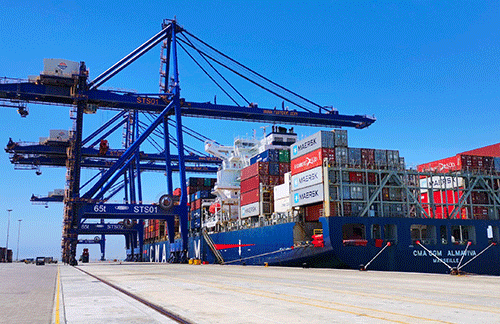Namibia’s trade with BRICS countries during 2022 stood at a mammoth N$97 billion. This figure was shared yesterday by head of research at High Economic Intelligence, Salomo Hei, who said Namibia’s trade with BRICS is higher than any other economic bloc.
Addressing a breakfast session hosted by Debmarine Namibia, he noted that Namibia’s total trade with various economic blocs in 2022, including the Southern African Customs Union (SACU) which amounted to N$85.3 billion, was combined with trade with the United States of America (USA), UK and the Euro area amounting to N$43.1 billion.
Namibia’s trade with new BRICS members, who are expected to join in January 2024, amounted to N$12.5 billion in 2022.
BRICS currently consists of Brazil, Russia, India, China and South Africa. Formally launched in 2009, BRICS now accounts for 23% of global GDP and 42% of the world’s population.
At the recent BRICS meeting in South Africa, countries such as Argentina, Egypt, Ethiopia, Iran, Saudi Arabia and the United Arab Emirates were invited to become full members of BRICS.
More interestingly, Namibia attended the latest BRICS summit for the first time ever to observe proceedings without actual participation. However, questions about Namibia’s intention to join the global bloc remain in the public domain after BRICS announced expansion plans.
South African president Cyril Ramaphosa said there is global momentum for the use of local currencies, alternative financial arrangements, and alternative payment systems to rival the USA’s historic dominance. However, South Africa’s finance minister Enoch Godongwana last week told the media that the issue of a Brics currency has not been proposed, not even in informal meetings.
“Setting up a common currency presupposes setting up a central bank, and that presupposes losing independence on monetary policies. I don’t think any country is ready for that,” Godongwana commented on the sidelines of the BRICS summit.
Despite this sentiment, Ramaphosa said BRICS is ready to explore opportunities for improving the stability, reliability and fairness of the global financial architecture.
As such, BRICS summit participants agreed to task finance ministers and central bank governors to consider the issuance of local currencies, payment instruments and platforms. In this regard, BRICS leaders expect a report on the matter at the next annual summit.
Commenting on domestic implications of a new common currency being propagated by BRICS, Hei said: “By extension, we are already part of that because of SA due to the currency peg. So, whatever SA decides upfront will immediately mean that we are on that train. Numbers showed that we are highly linked to BRICS, as there is a huge component of our activities with the BRICS bloc”.
President Hage Geingob participated in the recent BRICS-Africa Outreach as well as the BRICS Plus Dialogues with the objective to strengthen economic ties with bloc members and summit attendees.
Furthermore, local economics and business researcher Josef Sheehama told New Era that the BRICS summit is beneficial to the Namibian economy, particularly since the Namibia dollar is pegged to the South African rand. This, he noted, should result in unlocking more benefits like development finance and increased trade and investment.
“These BRICS countries have a good relationship with Namibia. I see these meetings as a summit with the overall objective to create conditions for a sustainable, equitable and inclusive future. Namibia can capitalise on emerging opportunities to develop and adopt new technologies, and put in place the right regulations that will attract the investment needed,” Sheehama stated.


